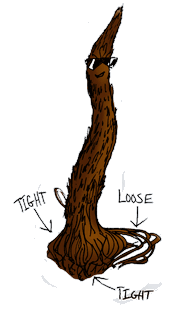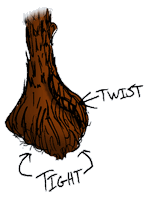How to Crochet Dreadlocks
A little background:
Back in the day using actual hooks on dreadlocks was hardly even known. When people talked about crocheting dreadlocks they were talking about a technique described below where the dreads are pulled through themselves to take up slack in the dread. This technique is now known as interlocking. It’s not just a maintenance technique, it’s actually used to start the dreads. Interlocking techniques are used primarily for micro “dreads” in African textured hair. In larger dreads, and in straighter hair textures, the technique is not usually used because of the thin, wrapped/braided look that it leaves.
Interlocking or crocheting of this type (which I will just call interlocking from now on) is not a good choice for tightening dreads. The wraps it leaves in the dreads are permanent scars. They create folding points, where the dreads bend un-naturally, and the hair in the wrap can never truly dread. The technique can be used for loops that stick out of a mature dread, but now that we have looks like the Lock Sculpta and the Lock Docta there are faster, better ways which leave no imperfections behind in the dread. In other words there’s no reason to interlock dreads unless you are making micro dreads, the really really small dreads (that are usually mistaken for braids) that are made up of wraps rather than knots (so they are not technically dreads).=]
Moving right along...
People have started using small crochet hooks to work on their dreadlocks. The techniques used are collectively called “Crocheting”. As you might imagine the results have been mixed. There are a lot of tools that qualify as crochet hooks, they vary greatly in size and in shape. The techniques used vary too. In a few short years crocheting dreadlocks has earned a reputation for destroying dreadlocks - yet many professional locticians and dreadlocks artists are able to get great results while not damaging the dreads at all.
The answer is never that easy is it? Crochet hooks are tools - the tool you use and the way you use it determine whether it’s good or bad -(hammer driving nail into wood = Good and Hammer driving thumb into wood = BAD) And don’t forget your goals either. Let’s say you get the right tool and use it the right way to make groomed, clean dreads......but you really wanted hairy, loose dreads that look like their starving....then this tool is not for you, even if you can use it well.
Yea, pretty much. If what you want to do is improve the way your dreads look while making them stronger I can help you out by providing the right dreadlocks crochet tool and the right crocheting techniques. Here's how...
As soon as I learned about crocheting dreadlocks I started testing and experimenting with different tools and techniques. Initially I thought crocheting was pretty cool and I figured I’d learn which crafting hook worked best so I could recommend it. If people were really into it we could become a re-seller of that hook.
Well, after buying and working with TONS of hooks I didn’t really have a “favorite” - instead I had 3 that were better than the rest. By this time I had enough experience with crocheting that I was sure that the crochet hook was an amazing dreadlocks tool. I got to work combining the best features of my 3 best crochet hooks in to one hook with all the good stuff. Since the objective of a dreadlocks crochet hook is different than that of a crafting crochet hook I found other ways to improve on the designs. Specifically, ways to make the hook dread safe. The result was our first prototype. Several revisions and prototypes later the Lock Sculpta was born.
Custom designed for crocheting dreadlocks the Lock Sculpta is unmatched; It’s safer for your dreads than any other crochet hook and at the same time more effective. In fact we Guarantee both of these claims.
Check out the Lock Sculpta page and meet a new friend! =]
...which is now called interlocking dreadlocks. This used to be a popular method for tightening up the loops on mature dreads. Please note that interlocking should never be used for tightening roots unless your dreads were started by interlocking. The problem with using it to tighten roots is that the hair at the base of the dread that you have crocheted will be twisted instead of dreaded. Loose hair at the roots can eventually get knotty and dread up but twisted hair will continue to lay twisted since it will be held at both ends. The roots will look much better right after you interlock them but the hair in the twist will never have a chance to get knotted and it will never dread. The long term effect of this will be dreads that look much thinner and bend more easily in some areas than others which makes them appear broken or weak in areas. And it kinda looks like a braid in the middle of your dread. So don't do it! :)

Loose hair at the roots. It's normal, but too much makes the dreads look messy and helps them grow together. The further the dread locks from the scalp the more loose hair you'll get in the future.

A dread interlocking itself.
Dreads almost never do this in captivity.
(they know better)

As you can see interlocking leaves a twist. No fun. For hair that is long and knotted at the roots use clockwise rubbing to create knots it in. If it's loose hair that is only attached at the scalp, use the loose hair tool or Lock Sculpta to pull it into the dread.

